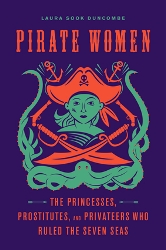 Pirates and Privateers Pirates and Privateers
The History of Maritime
Piracy
Cindy Vallar, Editor
& Reviewer
P.O. Box 425,
Keller, TX 76244-0425
    
Books for
Adults ~ Biography: Pirates, Privateers, & Pirate
Hunters

Pirate Women: The Princesses, Prostitutes, and
Privateers Who Ruled the Seven Seas
By Laura Sook Duncombe
Chicago Review Press, 2017, ISBN 978-1-61373-601-2, US
$26.99 / CAN $35.99
Also available in other formats
    
Men and victors
have been the predominant recorders of
events throughout history. Their opinions
and societal norms color their
objectivity. As a result, women and their
participation in historical events are
either omitted from these accounts or
given short shrift. Or as Duncombe writes:
“Pirates live outside the laws of man, but
women pirates live outside the laws of
nature.” (xi) This is a reality that
she encountered time and again in her
research for this book. A prime example is
Grace O’Malley, one of the few names the
general public readily recognizes.
Although this Irish “pirate queen” was a
major thorn in the side of the English and
had a private meeting with her
contemporary, Queen Elizabeth I, archival
mention of her is scant. It is the bards
of Ireland who have kept her alive.
In this highly readable and interesting
account, Duncombe collects the known women
who dared to become pirates. This book is
far more than just a look at
well-researched history; among the women
here one finds fictional female rogues
too. She shares what is known about these
people, as well as what is missing about
them. In the process, she clearly
identifies whether this information can be
proven historically or if it’s just a
myth. She asks thought-provoking questions
along the way to stimulate readers’
curiosity and further discussion.
The women who are often discussed in
pirate histories – including Queen Teuta
of Illyria, Anne Bonny, Mary Read, Cheng I
Sao, and Grace O’Malley – are found in
this collection. So are names that rarely
see the light of day, such as Sayyida
al-Hurra, Maria Cobham, Lai Choi, and
Rachel Wall. Duncombe even mentions the
suggestion that Bartholomew Roberts might
have been a woman in disguise. Rather than
use footnotes or end notes, she seamlessly
weaves source information into her text,
removing the need to search for this
elsewhere and thus break the narrative's
flow. Pirate Women also includes
fictional pirates, such as Anne de Graaf,
Jacquotte Delahaye, and Gunpowder Gertie.
Duncombe provides an index and “To Find
Out More” lists for general pirate and
chapter-by-chapter subject resources. Most
of the latter are secondary and tertiary
sources, rather than primary documents.
What this book is not is strictly a
history of women pirates. Duncombe tends
to stray from that narrow theme, but with
purpose, and she always returns to the
original subject before moving on to the
next pirate. Examples of this come when
she discusses courtesans in ancient times,
Sultan Süleyman the Magnificent’s marriage
to one of his concubines, or binding
women’s feet in China. Her use of a broad
definition of piracy allows her to
demonstrate the evolution of what
constitutes piracy in different time
periods. It also permits the inclusion of
women who have no direct connection to
maritime piracy, such as Cheng Chui Ping,
a snakehead (human trafficker).
The weakest chapter in this book is the
last, “The Pirates of the Silver Screen.”
Although several pirate films are
discussed because they focus on fictional
female pirates, Duncombe also examines Bonnie
and Clyde and An Unmarried Woman
– neither of which involves pirates. She
concludes the chapter with a criticism on
Hollywood’s portrayal of and treatment of
women in film.
Pirate Women is a good introduction
to female pirates and the eras in which
they lived. As Duncombe says, “Pirate
women deserve a spot next to their more
famous male counterparts because yearning
to escape the confines of an ordinary life
and to live on one’s own terms is not an
exclusively male feeling.” (228) Her
purpose in writing this book is to inspire
the next generation of women to strive to
be innovators. But are pirates the best
role model to achieve this goal?
There are several reasons why Pirate
Women is a valuable addition to the
handful of books that deal exclusively
with these females predators. Presented in
chronological sequence from ancient times
to the present, it is an extensive list
that includes far more than any other
volume. Earlier titles often focus on only
a small sample or examine women associated
with piracy, but who aren’t actually
pirates themselves, during a specific time
period. More importantly, Duncombe
incorporates the society, culture, and
historical events of the period in which
each woman lives. This means she examines
them as part of a whole, rather than a
single aspect of their lives. Equally
noteworthy is the inclusion of the people
who have told each pirate’s story and how
their motivations impacted their
renderings of her.
Note to readers: I always
attempt to provide readers with a fair
review that points out a book's pros and
cons. I would be remiss in not letting
you know that Laura Duncombe includes me
in her acknowledgements and one of my
piracy articles is quoted in her
narrative.

Click to contact me
Background image compliments
of Anke's Graphics |

